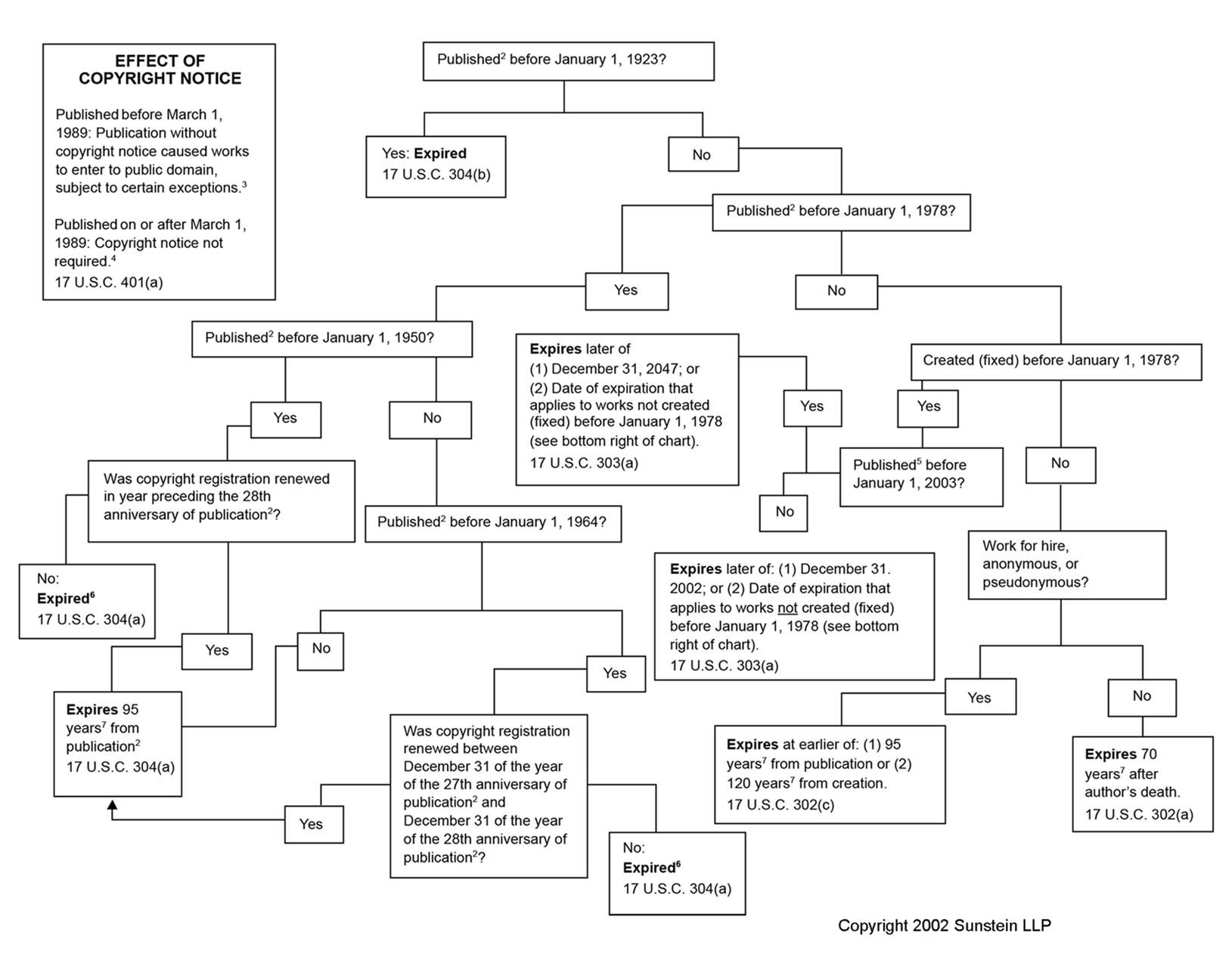Copyright Flowchart
Flowchart for determining when copyrights in fixed work1 expire.

Footnotes
For more information, contact Joel Leeman (jleeman@sunsteinlaw.com) or another attorney in our Copyright Practice Group. We recommend contacting an attorney before relying on any conclusions concerning the copyright status of a work reached using this flowchart. Please see the Sunstein Copyright Durations web page for general background regarding copyright duration.
1“Fixed” means fixed, by the author or with the author’s permission, in a tangible means of expression, including, for instance, paper, CD-ROMs, film, or other media. The federal copyright statute does not cover unfixed works (such as oral stories or performances that have not been recorded or were recorded without the author’s permission); they may be protected under state law.
2“Published” is a technical term that is both broader and narrower than the lay definition. For instance, in general it requires, among other things, the copyright owner’s authorization. In some situations, distribution of even a single copy of a work may constitute publication for copyright purposes.
Before January 1, 1978, the copyright term began on the date the work was published or, if a work was registered as an unpublished work, on the registration date. Registration of unpublished works was relatively rare, as only certain types of works, such as lectures, photographs, works of art, and motion pictures, were accepted by the Copyright Office for registration as unpublished works. All other types of works, including books and periodicals, could be registered only upon publication. In reading the flowchart, if a work was registered before publication, replace “published” with “registered” and “publication” with “registration.”
Publication in the U.S. before January 1, 1978 without a copyright notice did not start the copyright term. If the published work had a copyright notice, but the notice showed a year of publication that was earlier than the actual publication, the copyright term could be correspondingly shortened. With respect to foreign publication, there is a split of authority as to whether publication in another country could start the clock running on the copyright term if the work was published without a copyright notice.
3Because of various exceptions, it is not possible to conclude simply by virtue of the absence of (or a defect in) a copyright notice on a copy of a work, that the work has entered the public domain. For example, copyright was not lost if the copyright owner did not authorize the copy, if the notice was omitted in violation of written agreement with the copyright owner, if the notice was omitted from a small number of copies (under some circumstances), or, for works published between January 1, 1978 and March 1, 1989, if the work was registered within five years after publication without notice, if reasonable efforts were made to add notices after the omission was discovered.
Copyrights for certain foreign works (with at least one non-U.S. author and first published abroad), lost due to omission or defect in the copyright notice, were restored (on January 1,1996 for most countries) if the work was not yet in the public domain in the country of first publication and if certain other requirements were met. Finally, some authorities have held that the copyright notice requirement did not apply to publication outside of the U.S.
4Although copyright notice has not been required since March 1, 1989, notice does provide certain benefits and should be used.
5As mentioned above in note 2, in general, publication requires the copyright owner’s authorization. The courts have not yet addressed whether distribution that was not authorized by the copyright owner constitutes “publication” for purposes of determining whether a work created before January 1, 1978 is entitled to a term until at least December 31, 2047 by virtue of being published before January 1, 2003.
6The same law mentioned above that restored the copyright in certain foreign works that entered the public domain in the U.S. due to lack of copyright notice also restored copyrights in such works that were lost due to failure to renew the registration. For such works, copyright expires 95 years from publication (or registration as an unpublished work).
7These terms of copyright run through the end of the calendar year in which the copyright would otherwise expire.
View our Inter Partes Review Flowchart
This flowchart shows a typical timeline for IPR proceedings with key deadlines that guide the reader from before the filing of a petition for an IPR all the way to the appeals process after conclusion of an IPR.
We use cookies to improve your site experience, distinguish you from other users and support the marketing of our services. These cookies may store your personal information. By continuing to use our website, you agree to the storing of cookies on your device. For more information, please visit our Privacy Notice.